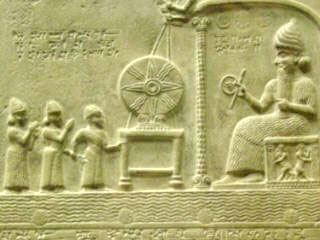|
Part 3 In part two of this feature we ended by saying the next step would be to start cataloging those who have come through stargates of the past, the present, and the powerful ones perched to do so in the near future. This section of study requires two primary assumptions. The reader will note that versions of these assumptions are accepted by general camps of Ufology--both those from restrictively the Biblical worldview and those outside that view. The assumptions are:
Since the religion of Sumeria was the first known organized mythology and greatly influenced the foundational beliefs of the forthcoming nations of Assyria, Egypt, Greece, Rome, and others, the question of origin of Sumerian belief has interested scholars and historians for more than a millennium. Specifically, where does one find the beginning of the gods of Sumeria? Were the Sumerian deities the product of human imagination, or the distortion of an earlier prehistoric revelation? Were they the "mythologizing" of certain heroes, or as subscribers of the Ancient Astronaut theory believe, the result of an extra-terrestrial "alien" visitation whose appearance gave birth to legends and gods of mythology? More importantly, did the gods of Sumeria reflect the emergence of a real, perhaps spiritual influence operating through pagan dynamics, or were the gods purely the creation of primitive imagination? These questions are both fascinating and difficult since the deities of ancient Sumeria/Mesopotamia continue to be shrouded in a history of unknown origins. It was as though from "out of nowhere" the Sumerians sprang onto the scene over 5,500 years ago, bringing with them the first written language and a corpus of progressive knowledge—from complicated religious concepts, to an advanced understanding of astrology, chemistry, and mathematics. The three common theories regarding the origin of Sumerian myth are:
The Euhemerus View was based on the theories of the Greek scholar Euhemerus, who claimed the pagan gods originated with famous ancient kings who were later deified. The more popular theories—the Ancient Astronaut and the Biblical View—apply an "event" that is believed to have occurred, where early humans were visited--perhaps even altered--by super intelligent beings. To some, these visitors were "angels" and/or "demons" while to others they were advanced humanoids.
The beginning Evidence suggests that the earliest legends of myth were preceded by a belief in "the God" as the creator of all things and the "ruler of heaven." A later struggle between the "ruler of the heavens" versus the "power of the air" occurred in Sumerian mythology after Enki, the god of wisdom and water, created the human race out of clay. It appears that Anu, who was at first the most powerful of the Sumerian gods and the "ruler of the heavens," was superseded in power and popularity by Enlil, the "god of the air." (To the Christian mind this could be perceived as a record of Satan, the god of the air, continuing his pretence to the throne of God, and his usurpation of Yahweh—"the Lord of the heavens.") Correspondingly, in the Enuma elish (a Babylonian epic), Marduk, the great god of the city of Babylon, was exalted above the benevolent gods and extolled as the creator of the world. Marduk was symbolized as a dragon called the Muscrussu, and his legend also appears to contain several similarities of the biblical account of creation. The Adapa Epic likewise tells a Babylonian legend roughly equivalent to the Genesis account of creation. In it, Adapa, like Adam, underwent a test on food consumption, failed the test and forfeited his opportunity for immortality. As a result of the failure, suffering and death were passed along to humanity. Finally, in the Epic of Gilgamesh we find startling similarity of the Biblical record, deeply rooted in ancient Assyrian and Babylonian mythology.
Consequently, the gods determined to exterminate the human race. Enki, the lord of the waters, was not happy with the other gods for this decision and warned Utnapishtim of the coming deluge, instructing him to tear down his house and to build a great boat. Utnapishtim obeyed Enki, built the vessel, and sealed it with pitch and bitumen. The family of Utnapishtim loaded onto the boat together with various beasts and fowl. When the rains came, the doors were closed and the vessel rose up above the waters. Like Noah, Utnapishtim sent out a dove, and later a swallow, to search for dry land. They both returned. Later, a raven was released and it never came back. After several more days the boat came to rest on the top of a mountain where Utnapishtim built an altar and offered a sacrifice of thanksgiving to the gods. As the gods smelt the sweet offering, all but Enlil repented for sending the flood.
Scholars began to wonder: If Gilgamesh actually lived, should anything be made of stories about his superhuman status as a demi-god? He was said to be two-thirds god and one-third human, like the Biblical accounts of Nephilim--part-human part-angel beings, which descended through gateways in heaven, and became "mighty men which were of old, men of renown" (Gen. 6:4). Were other records of myth potentially the accounts of actual interaction between Heroes and men? Hybrids!? Biblical and extra-biblical records seem to indicate there might be more to mythology than myth. In my second book, The Gods Who Walk Among Us, I began:
Yet while the prehistoric people of the East looked to the Sumerians for their supply of daily bread, the Sumerians themselves gazed heavenward to the early rising of Utu (Shamash), the all-providing sun god, as he prepared once again to ride across the sky in his mule-drawn chariot. Utu was not alone among the gods. By now the Sumerian pantheon provided the earliest known description of organized mythology, consisting of a complex system of more than 3,000 deities and covering nearly every detail of nature and human enterprise. There were gods of sunshine and rain. There were vegetation gods, fertility gods, river gods, animal gods, and gods of the afterlife. There were the great gods—Enlil (prince of the air), Anu (ruler of the heavens), Enki, (the god of water), and more. Under these existed a second level of deities, including Nannar the moon god, Utu the sun god, and Inanna, the "Queen of Heaven". These religious concepts derived according to some scholars following earth visitation by super-intelligent beings, about whom the mythology of the gods were based. As the centuries passed, the god and goddess worshipping cities of the Sumerians began to fade away. The flourishing fields of agriculture that provided the underpinnings of the great Sumerian economy were depleted of fertility through over-irrigation, and residues of salt build-up appeared to chaff the surface of the land. The city-states of Sumeria; Kish, Ur, Lagash, and Umma, damaged by a millennium of ruthless infighting among the Sumerians, finally succumbed to militant external forces. The barbarian armies of the Elamites (Persians) invaded and destroyed the city of Ur, and Amorites from the west overran the northern province of Sumer and subsequently established the hitherto little-known town of Babylon as their capital. By B.C.1840, Hammurabi, the sixth king of Babylon, conquered the remaining cities of Sumeria and forged northern Mesopotamia and Sumeria into a single nation. Yet the ultimate demise of the Sumerian people did not vanquish their ideas. Sumerian art, language,
literature, and especially religion, was forever absorbed into the cultures
and
Such gateways (stargates) were represented on earth in Assyrian archways built through elaborate construction ceremonies and blessed by names of good omens. Colossal transgenic creatures stood guard at the gates and palace entries to keep undesirable forces from coming through the portals--important imitative magic thought to represent heavenly ideas--guardians that were often accompanied by winged spirits holding magic devices and magic statuettes concealed beneath the floors.
Ashur is believed to be a later version of Ahura-Mazda, the good god of Zoroastrianism who is opposed by Ahriman. In each case these very ancient beings are depicted coming through or descending from the sky on flying disks. Similar stories are repeated in Egyptian hieroglyphs as well as in the literature of Greece and other cultures around the world. A principal benefactor of these ideas, and a people who would ultimately make their own contributions to the ancient mythologies, was an old and flourishing population of agrarians known as the Egyptians. By the year B.C. 1350, Egyptian dominance had spread from Syria and Palestine into the farthest corners of the Fertile Crescent. From northern Mesopotamia to the Baltic Sea, the pharaohs of Egypt had established themselves as the social and economic leaders of the civilized world, ruling an area more than 2,000 miles in length. The military superiority of the Egyptian army demonstrated the ability to subdue the threat of resistance, maintaining a hegemony that extended from the Nubians to the Hyksos. Yet in the final analysis, it was the influence of the gods of Egypt—their magic, myths, and rituals—that provided the Egyptians with a lasting place in history and brought following generations into an immense, "enlightening" description of ancient mythology, including a wealth of information regarding the dynamics and supernatural possibilities of pyramids, paganism, and portals.
Facts About Atum (RA), Osiris and Isis Prehistoric Egyptians held the premise that the oceans preceded and in some way contributed to the creation of the living cosmos. From the Fifth Dynasty Pyramid Texts, the Heliopolitan theory of creation states that Atum (the sun god Ra) independently created himself from a singular expression of self will—an act visualized by the Egyptians as a divine egg that appeared upon the primordial waters of the all-filling ocean called Nun, out of which Atum (meaning He who created himself), emerged. Egyptians described Ra as navigating the heavens in a flying "boat." Horus was a descendant of Ra and flew through the heavens on a winged disk as well, which "shined with many colors." A hieroglyphic in the temple at Edfu describes one such event:
Second act of creation and a flying eye According to myth, a second act of creation
developed around a divine masturbation when Atum, the great "He-She", orally
copulated himself and afterward regurgitated his children—Shu and Tefnut—who
assumed the positions of god and goddess of air and moisture. Later, when
Shu and Tefnut became lost in the universal ocean of Nun, Atum exhibited his
paternal care by sending out his Eye, which had
The flying Eye of Atum found the child gods and eventually returned to discover that Atum had grown impatient during the wait and had created a second eye. In order to placate the hostility that developed between the two divine eyes, Atum affixed the first eye upon his forehead where it was to oversee and rule the world of creation. Thus the Eye of Atum became the jealous, destructive aspect of the sun god Ra. To avoid getting lost again in the all-filling waters of Nun, Shu and Tefnut procreated Geb (the earth), and Nut (the sky), and thus provided the more stable elements of earth, nature, and the seasons. Later, Geb was conceptualized as cohabiting with Nut and producing four children of his own: Seth, Osiris, Isis, and Nephthys. Of these, Osiris and Isis grew into such important cult deities that the mythology of the Egyptian religion was modified to support the claim that Osiris, with the help of his sister-wife Isis, had nearly overthrown and replaced Ra as the most powerful of the gods—an action that so enraged his brother Seth that the hateful and jealous sibling killed him. Seth's murderous act was followed by the jackal-headed god, Anubis, assisting Isis with the embalming of her slain husband-brother Osiris, an act through which Anubis secured his position as "the god of embalming." Then, while still in mourning, Isis summoned the wisdom of Thoth which she combined with her own proficient magical skills and produced a resurrected Osiris, who, in turn, impregnated her with Horus, the god of daylight. Horus promptly avenged his fathers death by killing the evil brother Seth. Another version of the myth claims that Horus was born to Isis only after she impregnated herself with semen which she took from the corpse of Osiris--evidence of advanced DNA cloning. The god Seth was angry and sought to destroy Horus. Note how Isis escapes in a flying craft--the Boat of the Celestial Disk, as recorded in the Metternich Stella:
Yet another story claims that Seth persuaded his brother Osiris to climb into a box, which he quickly shut and threw into the Nile. Osiris drowned and his body floated down the Nile river where it snagged on the limbs of a tamarisk tree. In Byblos, Isis recovered the body from the river bank and took it into her care. In her absence, Seth stole the body again and chopped it into fourteen pieces, which he threw into the Nile. Isis searched the river bank until she recovered every piece, except for the genitals, which had been swallowed by a fish (Plutarch says a crocodile). But Isis simply replaced the missing organ with a facsimile and somehow was able to reconstruct Osiris and impregnate herself with the ithyphallic corpse. This portion of the Isis/Osiris myth may have been developed over time to provide the legend necessary to sanction the kind of temple prostitution practiced during the rituals of Isis. Temple prostitutes represented the human manifestation of the goddess and were available for ritual sex as a form of imitative magic. Much of the details are no longer available, but it appears these prostitutes usually began their services to the goddess as a child and were deflowered at a very young age by a priest, or, as Isis was, by a carved phallus of the god Osiris. Sometimes prostitutes were chosen, on the basis of their beauty, as the mates of sacred temple bulls. Such bulls were considered the incarnation of Osiris, whereas in other places, such as at Mendes, temple prostitutes were offered in coitus to divine goats. Regardless, from this time forward Osiris was considered the chief god of the deceased and the judge of the netherworld—the dark and dreary underworld region of the dead. In human form Osiris was perceived as a mummy and, paradoxically, while he was loved as the guarantor of life after death, he was feared as the demonic presence that decayed the bodies of the dead. Such
necromantic
worship of Osiris and Isis grew to become an important part of several
Mediterranean religions, with the most famous cult center of Osiris at
Abydos in Upper Egypt where an annual festival reenacted his death and
resurrection. In Abydos, Osiris was called the god of the setting sun—the
mysterious "force" that ruled the region of the dead just
In the funerary texts known as the Book of the Dead, the most elaborate magical steps were developed around the Osiris myth to assist the Egyptians with their journey into the afterlife. It was believed that every person had a Ka—a spiritual and invisible duplicate—and that such Ka accompanied them throughout eternity. Since the Ka provided each person with a resurrected body in the kingdom of the dead, but could not exist without the maintenance of the earthly body, every effort was made to preserve the human corpse. The body was therefore mummified according to the elaborate magic rituals passed down from Isis, who, according to legend, singularly perfected the rituals of mummification through her work on Osiris. Wooden replicas of the body were also placed in the tomb as a kind of substitute in case the mummy was accidentally destroyed, and additional protection for the corpse was provided through the construction of ingenious burial tombs specifically designed to hide and preserve the human body for all of eternity. Finally, curses were placed throughout the tomb as a warning to intruders. At death the Egyptian Ka departed from the human body and, accompanied by the hymns and prayers of the living, used the formulas memorized from the funerary texts to outsmart the horrible demons seeking to impede the Ka's progress into the kingdom (or hall) of Osiris. Arriving at the judgment hall, the heart of the Ka was "weighed in the balance" by Osiris and his 42 demons. If the deceased was found lacking in virtue, he was condemned to an eternity of hunger and thirst. If the Ka was determined to have belonged to an outright "sinner", it was cut to pieces and fed to Ammit—the miserable little goddess and "eater of souls." But if the deceased was judged to have lived a virtuous life, the Ka was granted admittance into the heavenly fields of Yaru, where foods were abundant and pleasures unending. The only toil in this heaven was to serve in the grain fields of Osiris, and even this could be obviated by placing substitutionary statues, called shawabty, into the tomb.
Back to Contents Next - Part Four
|
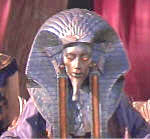
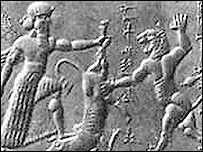 In
1872 George Smith discovered the Gilgamesh tablets while doing research on
the Assyrian library of Ashurbanipal at the British Museum. As he
interpreted the text, a legend emerged: Gilgamesh, the king of the city of
Uruk, was told about a great flood from his immortal friend, Utnapishtim
(the Sumerian equivalent of Noah). Utnapishtim described for Gilgamesh how
the great god Enlil had decided to destroy all of mankind because of its
sins. A plague was sent but failed to persuade mankind of better behavior.
In
1872 George Smith discovered the Gilgamesh tablets while doing research on
the Assyrian library of Ashurbanipal at the British Museum. As he
interpreted the text, a legend emerged: Gilgamesh, the king of the city of
Uruk, was told about a great flood from his immortal friend, Utnapishtim
(the Sumerian equivalent of Noah). Utnapishtim described for Gilgamesh how
the great god Enlil had decided to destroy all of mankind because of its
sins. A plague was sent but failed to persuade mankind of better behavior.
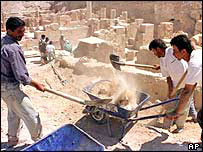 Sound
familiar? For over a hundred years the story of Gilgamesh was considered by
many to be nothing more than myth. Then, in April of 2003, Archaeologists in
Iraq announced the discovery of what they believed to be
Sound
familiar? For over a hundred years the story of Gilgamesh was considered by
many to be nothing more than myth. Then, in April of 2003, Archaeologists in
Iraq announced the discovery of what they believed to be
 social academics of the nations surrounding Mesopotamia, including the
Hittite nation, the Babylonians, and the ancient Assyrians... and something
else: the story of flying disks, the gods who flew in
them, and gateways through which the evil and benevolent influences sought
entry.
social academics of the nations surrounding Mesopotamia, including the
Hittite nation, the Babylonians, and the ancient Assyrians... and something
else: the story of flying disks, the gods who flew in
them, and gateways through which the evil and benevolent influences sought
entry.  Sumerian
engravings on clay cylinders speak of these flying disks. Very similar
winged disks are found throughout Assyrian mythology in association with
Ashur, the flying god of war.
Sumerian
engravings on clay cylinders speak of these flying disks. Very similar
winged disks are found throughout Assyrian mythology in association with
Ashur, the flying god of war.  the curious habit of detaching itself from Atum and of thinking independent
thoughts, to look for them.
the curious habit of detaching itself from Atum and of thinking independent
thoughts, to look for them. 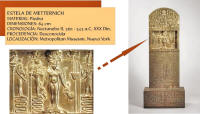
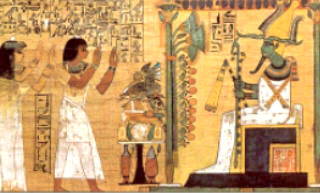 beneath the western horizon. He was venerated in this way primarily because
death, and specifically the fear of one’s estate after death, grew to
constitute so much of Egyptian concern.
beneath the western horizon. He was venerated in this way primarily because
death, and specifically the fear of one’s estate after death, grew to
constitute so much of Egyptian concern.